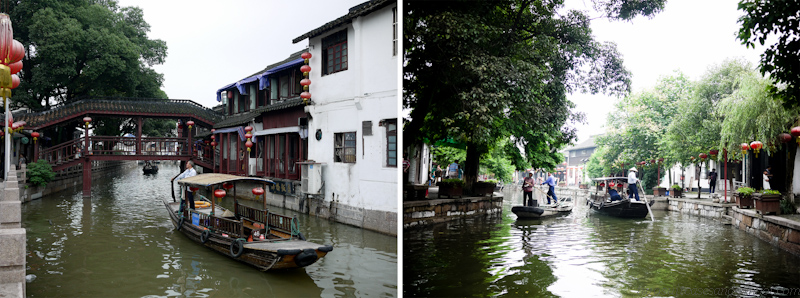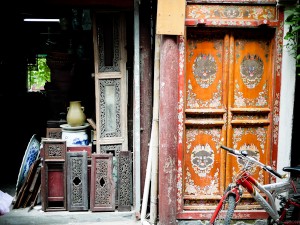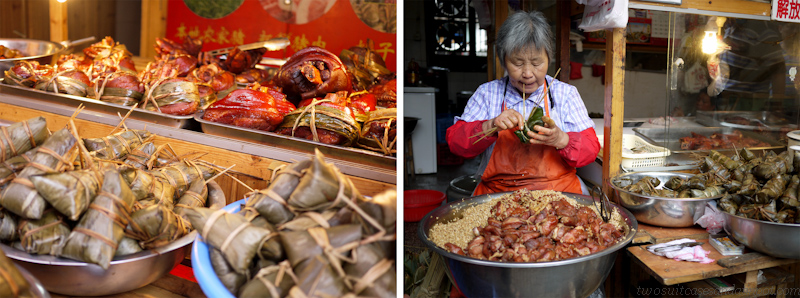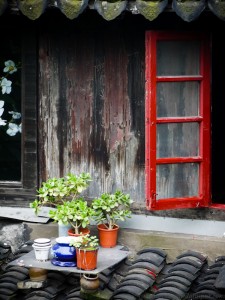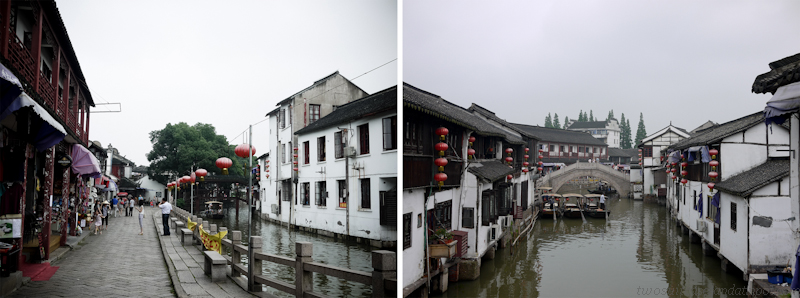Zhujiajiao is an ancient water town located on the Cao Gang River in the Qingpu district of Shanghai. Roughly 50 square kilometers of tree lined rivers and canals, winding cobbled lanes and well preserved Ming and Qing dynasty architecture lure hordes of day visitors keen to get out of the city for a bit. For this reason you should plan to get here early and preferably on a week day. By lunch time you will be fighting sweaty American tourists and hungry locals (who don’t ever seem to sweat) for the pork and pastries.
There are many temples, galleries, museums and old residences to explore here. The Kezhi Garden, Qing dynasty Post Office, Yuanjin Buddhist Temple, Tongtianhe Chinese Pharmacy, City God Temple, Y-Art Gallery, Shanghai Qianhua Art Gallery and Shanghai Handicraft Exhibition Hall all require an admission ticket, but entry into the town is free. The maze of pedestrian lanes house loads of shops selling traditional Chinese art work, engraved jade, delicate chopsticks (you can pick up a set engraved with your name in Chinese characters for US$0.50), silk clothing, duvets and pillows, scarves, jewellery, handmade embroidered bags and shoes, beautiful cheongsam (including the cutest little itty bitty ones for babies) and all the other usual tourist trap trinkets. But even though North Street is known as “a mile long road with a thousand shops” the discriminating tourist tax is high here, so unless you’re good at bargaining, don’t plan to come here purely for the shopping. Rather grab a tasty street snack and explore the stone cobbled lanes with their old style shopfronts and decorative red lanterns, walk down the quiet, deep alleyways or zigzag back and forth over the canals across the arched stone bridges.
There are loads of stalls selling a variety of foods from roasted pork knuckle to rose flavoured fermented bean curd, but one of Zhujiajiao’s proudest exports is the bamboo or reed leaf wrapped dark rice dumplings or zongzi. Also known as Grandma Dumplings (apo zong), the pillow shaped parcels of Zhujiajiao are wrapped with straw and are purportedly the best place in China to get them. That’s sort of like claiming that a certain shop in SA sells the best boerewors in the country. It’s a big freaken deal. And with some vendors selling up to 30 000 dumplings a day, this is a rumour best believed. The dumplings are stuffed with flavoured rice and may also include pork, red bean paste or red beans. Locals in the know recommend Xiaotian Apo Zong at 263 Bei Da Jie Lu as the best one to try. For dessert my favourite Zhujiajiao snack is the flaky, sweet and salty stocking sole pastries. Although Tongli is most famous for these sesame topped treats, the ones in Zhujiajiao are just as moreish. Like the zongzi, every stall seems to have a different recipe and some are better than others but, like sex and pizza, even the bad ones are good.
Zhujiajiao is crisscrossed with rivers and streams spanned by 36 bridges ranging from wood to stone and marble and built during the Ming and Qing dynasties. The biggest stone bridge is Fangsheng Bridge (Setting-fish-free Bridge). Here you can buy bags full of goldfish and set them free in the river for good luck. (Personally, I would rather throw salt over my shoulder. It’s not like they’re going to come swimming back like those birds you release, but still.) This is also the area to catch a ride on one of the man powered dragon boats. There are short (US$9.50 per boat) and long (US$19.00 per boat) routes covering different areas of the town and it’s really worth seeing the bridges, temples and buildings from this serene perspective. Each boat can seat up to 6 people. There are loads of restaurants, teahouses and bars lining the canals, and many have little balconies overhanging the water. Lovely places to grab a bite to eat and watch the world go by. Don’t always settle for the price on the menu – some establishments can be bargained down if you haggle before the meal.
Zhujiajiao can feel a bit like a tourist trap. This is probably because it is. The ancient part of the city covers 3 square kilometers and can get crowded at times. If prices aren’t displayed (as they often aren’t in China), make sure you get a fixed price before having to fork out 10 dollars for a cup of tea that tastes like the runny stuff at the bottom of a compost heap. (I don’t actually know what the runny stuff at the bottom of a compost heap tastes like, but I imagine it’s something like that.). But it is a wonderful place to spend the day, instantly transporting you back to what life must have looked like here 1700 years ago. Just, you know, with all the added plastic and cheap T-shirts and stuff.
Getting there: From Shanghai, take the Huzhu Express Line at People’s Square at the intersection of Pu’an Road and Jinling Road. It is an hour’s drive and costs US$2. There is a bus every half hour. Alternatively, take Line 2 on the metro all the way to Fuxing East and then catch a taxi. The ride should cost you around US$10.
For more info visit http://en.zhujiajiao.com/
